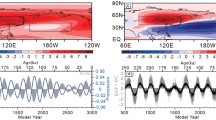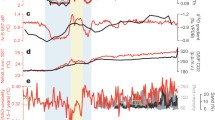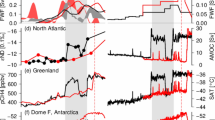Abstract
The influence of ice-sheet retreat on the El Niño–Southern Oscillation (ENSO) variability is studied using a transient simulation in NCAR-CCSM3 forced only by variations in continental ice sheets during the last deglaciation. The most striking feature is an abrupt strengthening of ENSO (by ~25 %) at 14 thousand years before present (ka BP) in response to a significant retreat (an equivalent ~25 m sea-level rise) of the Laurentide ice sheet (LIS). This abrupt intensification of ENSO is caused mainly by a sudden weakening of the equatorial annual cycle through the nonlinear mechanism of frequency entrainment, rather than an increase in the coupled ocean–atmosphere instability. The weakened annual cycle corresponds to a reduced north–south cross-equatorial annual mean SST contrast in the eastern Pacific. This reduced interhemispheric SST gradient—significant cooling north of the equator—is forced predominantly by an anomalous easterly from an abrupt polarward shift of the jet stream in the Northern Hemisphere, which extends to the northeastern tropical Pacific Ocean surface and is reinforced by the wind-evaporation-SST feedback then propagates equatorward; it could also be contributed by a fast sea-ice expansion and a consequent cooling in the North Pacific and North Atlantic that is induced by the retreat of the LIS.












Similar content being viewed by others
References
Bartlein PJ et al (1998) Paleoclimate simulations for North America over the past 21,000 years features of the simulated climate and comparisons with paleoenvironmental data. Quat Sci Rev 17:549–585
Broccoli AJ, Dahl KA, Stouffer RJ (2006) Response of the ITCZ to Northern Hemisphere cooling. Geophys Res Lett. doi:10.1029/2005GL024546
Budikova D (2009) Role of Arctic sea ice in global atmospheric circulation: a review. Glob Planet Change 68:149–163
Carré M et al (2014) Holocene history of ENSO variance and asymmetry in the eastern tropical Pacific. Science 345:1045–1048
Chang B, Wang T Li, Ji L (1994) Interactions between the seasonal cycle and the Southern Oscillation—frequency entrainment and chaos in a coupled ocean–atmosphere model. Geophys Res Lett 21:2817–2820
Chang L, Ji B Wang, Li T (1995) Interactions between the seasonal cycle and El Nino–Southern Oscillation in an intermediate coupled ocean–atmosphere model. J Atmos Sci 52:2353–2372
Chiang JC, Bitz CM (2005) Influence of high latitude ice cover on the marine Intertropical Convergence Zone. Clim Dyn 25:477–496
Clark PU, Alley RB, Pollard D (1999) Northern Hemisphere ice-sheet influences on global climate change. Science 286:1104–1111
Clement AC, Seager R, Cane MA (2000) Suppression of El Niño during the Mid-Holocene by changes in the Earth’s orbit. Paleoceanography 15:731–737
Cobb KM et al (2013) Highly variable El Niño–Southern Oscillation throughout the Holocene. Science 339:67–70
COHMAP, COHMAP project members (1988) Climatic changes of the last 18,000 years: observations and model simulations. Science 241:1043–1052
Collins M et al (2010) The impact of global warming on the tropical Pacific Ocean and El Niño. Nat Geosci 3:391–397
Conroy JL, Overpeck JT, Cole JE, Shanahan TM, Steinitz-Kannan M (2008) Holocene changes in eastern tropical Pacific climate inferred from a Galápagos lake sediment record. Quat Sci Rev 27:1166–1180
Crowley TJ (1992) North Atlantic deep water cools the Southern Hemisphere. Paleoceanography 7:489–497
Deser C, Walsh JE, Timlin MS (2000) Arctic sea ice variability in the context of recent atmospheric circulation trends. J Clim 13:617–633
Dong BW, Sutton R (2002) Adjustment of the coupled ocean–atmosphere system to a sudden change in the thermohaline circulation. Geophys Res Lett 29:18-11–18-14
Dyke AS (2004) An outline of North American deglaciation with emphasis on central and northern Canada. Dev Quat Sci 2:373–424
Eagle RA et al (2013) High regional climate sensitivity over continental China constrained by glacial-recent changes in temperature and the hydrological cycle. Proc Natl Acad Sci 110:8813–8818
Eisenman I, Bitz CM, Tziperman E (2009) Rain driven by receding ice sheets as a cause of past climate change. Paleoceanography. doi:10.1029/2009PA001778
Gu D, Philander S (1995) Secular changes of annual and interannual variability in the tropics during the past century. J Clim 8:864–876
Guilyardi E (2006) El Niño–mean state–seasonal cycle interactions in a multi-model ensemble. Clim Dyn 26:329–348
He F, Shakun JD, Clark PU, Carlson AE, Liu Z, Otto-Bliesner BL, Kutzbach JE (2013) Northern Hemisphere forcing of Southern Hemisphere climate during the last deglaciation. Nature 494:81–85
Jackson C (2000) Sensitivity of stationary wave amplitude to regional changes in Laurentide ice sheet topography in single-layer models of the atmosphere. J Geophys Res 105:24443–24454
Jin FF, Kim ST, Bejarano L (2006) A coupled-stability index for ENSO. Geophys Res Lett. doi:10.1029/2006GL027221
Kim ST, Jin F-F (2011a) An ENSO stability analysis. Part I: results from a hybrid coupled model. Clim Dyn 36:1593–1607
Kim ST, Jin F-F (2011b) An ENSO stability analysis. Part II: results from the twentieth and twenty-first century simulations of the CMIP3 models. Clim Dyn 36:1609–1627
Koutavas A, Joanides S (2012) El Niño–Southern Oscillation extrema in the Holocene and Last Glacial Maximum. Paleoceanography. doi:10.1029/2012PA002378
Lee SY, Chiang JC, Chang P (2014) Tropical Pacific response to continental ice sheet topography. Clim Dyn 44:2429–2446
Li C, Battisti DS (2008) Reduced Atlantic storminess during Last Glacial Maximum: evidence from a coupled climate model. J Clim 21:3561–3579
Liu Z (2002) A simple model study of ENSO suppression by external periodic forcing. J Clim 15:1088–1098
Liu Z, Alexander M (2007) Atmospheric bridge, oceanic tunnel, and global climatic teleconnections. Rev Geophys. doi:10.1029/2005RG000172
Liu Z, Kutzbach J, Wu L (2000) Modeling climate shift of El Nino variability in the Holocene. Geophys Res Lett 27:2265–2268
Liu Z et al (2009) Transient simulation of last deglaciation with a new mechanism for Bølling–Allerød warming. Science 325:310–314
Liu Z, Lu Z, Wen X, Timmermann A, Cobb KM (2014) Evolution and forcing mechanisms of El Niño over the last 21,000 years. Nature 515(7528):550–553
Masson-Delmotte V et al (2013) Ch. 5. In: Stocker TF et al. (eds) Climate Change 2013: The Physical Science Basis. Contribution of Working Group I to the Fifth Assessment Report of the Intergovernmental Panel on Climate Change. Cambridge University Press, Cambridge, pp 383–464
McPhaden MJ, Zebiak SE, Glantz MH (2006) ENSO as an integrating concept in Earth science. Science 314:1740–1745
Meehl GA, Teng H, Branstator G (2006) Future changes of El Niño in two global coupled climate models. Clim Dyn 26:549–566
Meehl GA et al (2007) Global climate projections. In: Solomon S et al (eds) Climate Change, 2007, Ch.10: The Physical Science Basis. Contribution of Working Group I to the Fourth Assessment Report of the Intergovernmental Panel on Climate Change. Cambridge University Press, Cambridge
Moy CM, Seltzer GO, Rodbell DT, Anderson DM (2002) Variability of El Niño/Southern Oscillation activity at millennial timescales during the Holocene epoch. Nature 420:162–165
Neelin JD, Battisti DS, Hirst AC, Jin FF, Wakata Y, Yamagata T, Zebiak SE (1998) ENSO theory. J Geophys Res Oceans (1978–2012) 103:14261–14290
Neelin JD, Jin FF, Syu HH (2000) Variations in ENSO phase locking. J Clim 13(14):2570–2590
Otto-Bliesner BL, Brady EC, Shin SI, Liu Z, Shields C (2003) Modeling El Niño and its tropical teleconnections during the last glacial-interglacial cycle. Geophys Res Lett. doi:10.1029/2003GL018553
Otto-Bliesner BL, Brady EC, Clauzet G, Tomas R, Levis S, Kothavala Z (2006) Last glacial maximum and Holocene climate in CCSM3. J Clim 19(11):2526–2544
Pausata F, Li C, Wettstein J, Kageyama M, Nisancioglu K (2011) The key role of topography in altering North Atlantic atmospheric circulation during the last glacial period. Clim Past 7:1089–1101
Peltier W (2004) Global glacial isostasy and the surface of the ice-age Earth: the ICE-5G (VM2) model and GRACE. Annu Rev Earth Planet Sci 32:111–149
Philander S, Gu D, Lambert G, Li T, Halpern D, Lau N, Pacanowski R (1996) Why the ITCZ is mostly north of the equator. J Clim 9:2958–2972
Pritchard MS, Bush AB, Marshall SJ (2008) Interannual atmospheric variability affects continental ice sheet simulations on millennial time scales. J Clim 21:5976–5992
Rein B, Lückge A, Reinhardt L, Sirocko F, Wolf A, Dullo WC (2005) El Niño variability off Peru during the last 20,000 years. Paleoceanography. doi:10.1029/2004PA001099
Roe GH, Lindzen RS (2001) The mutual interaction between continental-scale ice sheets and atmospheric stationary waves. J Clim 14:1450–1465
Russell JM et al (2014) Glacial forcing of central Indonesian hydroclimate since 60,000 year BP. Proc Natl Acad Sci 111:5100–5105
Shakun JD et al (2012) Global warming preceded by increasing carbon dioxide concentrations during the last deglaciation. Nature 484:49–54
Smith RS, Gregory J (2012) The last glacial cycle: transient simulations with an AOGCM. Clim Dyn 38:1545–1559
Stocker TF, Johnsen SJ (2003) A minimum thermodynamic model for the bipolar seesaw. Paleoceanography. doi:10.1029/2003PA000920
Timm O, Timmermann A (2007) Simulation of the last 21,000 years using accelerated transient boundary conditions. J Clim 20:4377–4401
Timmermann A, Lorenz S, An S, Clement A, Xie S (2007a) The effect of orbital forcing on the mean climate and variability of the tropical Pacific. J Clim 20:4147–4159
Timmermann A et al (2007b) The influence of a weakening of the Atlantic meridional overturning circulation on ENSO. J Clim 20:4899–4919
Trenberth KE, Branstator GW, Karoly D, Kumar A, Lau NC, Ropelewski C (1998) Progress during TOGA in understanding and modeling global teleconnections associated with tropical sea surface temperatures. J Geophys Res Oceans (1978–2012) 103:14291–14324
Tudhope AW, Chilcott CP, McCulloch MT, Cook ER, Chappell J, Ellam RM, Shimmield GB (2001) Variability in the El Niño–Southern Oscillation through a glacial-interglacial cycle. Science 291(5508):1511–1517
van Oldenborgh GJ, Philip S, Collins M (2005) El Niño in a changing climate: a multi-model study. Ocean Sci Discuss 2:267–298
Vettoretti G, Peltier WR (2013) Last glacial maximum ice sheet impacts on North Atlantic climate variability: the importance of the sea ice lid. Geophys Res Lett 40(24): 6378–6383
Wu L, He F, Liu Z (2005) Coupled ocean–atmosphere response to north tropical Atlantic SST: tropical Atlantic dipole and ENSO. Geophys Res Lett 32:L21712
Xie S-P (1999) A dynamic ocean–atmosphere model of the tropical Atlantic decadal variability. J Clim 12:64–70
Xie S-P, Philander SGH (1994) A coupled ocean–atmosphere model of relevance to the ITCZ in the eastern Pacific. Tellus A 46:340–350
Yeager SG, Shields CA, Large WG, Hack JJ (2006) The low-resolution CCSM3. J Clim 19(11):2545–2566
Zhang R, Delworth TL (2005) Simulated tropical response to a substantial weakening of the Atlantic thermohaline circulation. J Clim 18:1853–1860
Zhang X, Lohmann G, Knorr G, Purcell C (2014) Abrupt glacial climate shifts controlled by ice sheet changes. Nature 512:290–294
Zheng W, Braconnot P, Guilyardi E, Merkel U, Yu Y (2008) ENSO at 6 ka and 21 ka from ocean–atmosphere coupled model simulations. Clim Dyn 30:745–762
Zhu J, Liu Z, Zhang X, Eisenman I, Liu W (2014) Linear weakening of the AMOC in response to receding glacial ice sheets in CCSM3. Geophys Res Lett 41:6252–6258
Acknowledgments
The authors thank two anonymous reviewers for helpful comments on the earlier version of this paper. This work is supported by Chinese NSFC41130105 and MOST2012CB955200 and US NSF and DOE. We also gratefully acknowledge financial support from the China Scholarship Council.
Author information
Authors and Affiliations
Corresponding author
Electronic supplementary material
Below is the link to the electronic supplementary material.
Rights and permissions
About this article
Cite this article
Lu, Z., Liu, Z. & Zhu, J. Abrupt intensification of ENSO forced by deglacial ice-sheet retreat in CCSM3. Clim Dyn 46, 1877–1891 (2016). https://doi.org/10.1007/s00382-015-2681-3
Received:
Accepted:
Published:
Issue Date:
DOI: https://doi.org/10.1007/s00382-015-2681-3




